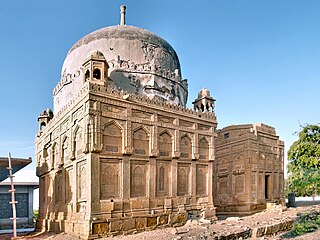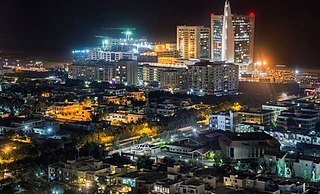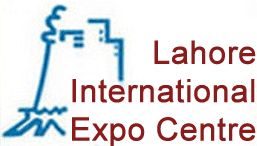
Karachi is the capital city of the Pakistani province of Sindh. It is the largest city in Pakistan and the 12th largest in the world, with a population of over 20 million. It is situated at the southern tip of the country along the Arabian Sea coast and formerly served as the capital of Pakistan. Ranked as a beta-global city, it is Pakistan's premier industrial and financial centre, with an estimated GDP of over $200 billion (PPP) as of 2021. Karachi is considered Pakistan's most cosmopolitan city, and among the country’s most linguistically, ethnically-, and religiously-diverse regions, as well as one of the country’s most progressive and socially liberal cities.

Transport in Pakistan is extensive and varied, and serves a population of over 240 million people. In recent years, new national highways have been built, with the addition of motorways which have improved trade and logistics within the country. Pakistan's rail network owned by Pakistan Railways is also undergoing expansion in recent years. Airports and seaports have been built with the addition of foreign and domestic funding. Transportation challenges in developing countries like Pakistan are escalating due to poor planning, inadequate governance, and corrupt practices. Consequently, these nations are grappling with a significant crisis in their transportation systems.

Bahawalpur is a city in the Punjab province of Pakistan. It is one of the ten largest cities of Pakistan and 6th most populous city of Punjab. Bahawalpur is the capital of Bahawalpur Division.

Hyderabad is a city and the capital of Hyderabad Division in the Sindh province of Pakistan. It is the second-largest city in Sindh, and the fifth largest in Pakistan.

Sukkur is a city in the Pakistani province of Sindh along the western bank of the Indus River, directly across from the historic city of Rohri. Sukkur is the third largest city in Sindh after Karachi and Hyderabad, and 14th largest city of Pakistan by population. New Sukkur was established during the British era alongside the village of Sukkur. Sukkur's hill, along with the hill on the river island of Bukkur, form what is sometimes considered the "Gate of Sindh".

Mirpur Khas is the capital city of the Mirpur Khas District and Mirpur Khas Division in the Sindh province, Pakistan. Mirpur Khas is the 6th largest city in Sindh province and the 34th largest city of Pakistan. The city was built by Talpur rulers of Mankani branch. According to the 2017 Census of Pakistan, its population is 233,916. Mirpur Khas is known for its mango cultivation, with hundreds of varieties of the fruit produced each year - it is also called the “City of Mangoes,” and has been home to an annual mango festival since 1955. After the completion of Hyderabad-Mirpurkhas dual carriage way, the city has become hub of commercial activities.

Bahawalpur District is a district of Punjab, Pakistan, with capital the city of Bahawalpur. According to the 1998 Census it had a population of 2,433,091, of which 27.01% were urban. Bahawalpur district covers 24,830 km2. Approximately two-thirds of the district (16,000 km2) is covered by the Cholistan Desert, which extends into the Thar Desert of India. The district is a major producer of cotton.

Karachi is the financial and industrial capital of Pakistan. As of 2019, Karachi has an estimated GDP (PPP) of $164 billion. The city accounts about half of the total collections of the Federal Board of Revenue, out of which, approximately half are customs duty and sales tax on imports. Karachi produces about 30 percent of value added in large-scale manufacturing, 25% of the GDP, the World Bank identified Karachi as the most business-friendly city in Pakistan. In 2010, research by the global human resources company Mercer found Karachi to be the most inexpensive city in the world.

Gulshan Town is a Karachi borough in the northeastern part of Karachi. Gulshan Town was formed in 2001 as part of the Local Government Ordinance 2001, and was subdivided into 11 union councils. The town system was disbanded in 2011, and Gulshan Town was reorganized as a subdivision of Karachi East District in 2015.

The four provinces, capital territory, and two autonomous territories of Pakistan are subdivided into 39 administrative "divisions", which are further subdivided into districts, tehsils, and finally union councils. These divisions were abolished in 2000, but restored in 2008.
Industrial Development Bank of Pakistan is located in Karachi, Sindh, Pakistan. It is among the oldest financing institutions in Pakistan.

Shezan International Limited is a Pakistani beverage manufacturer based in Lahore. It is one of the biggest food and beverage manufacturers in Pakistan. Two of their most famous brands are All Pure and Twist. This company is a part of Shahnawaz Group and is traded on the Pakistan Stock Exchange.
Nabi Bakhsh Khan Baloch was a Baloch research scholar, historian, sindhologist, educationist, linguist and writer. He predominantly wrote in Sindhi, but sometimes in Urdu, English, Persian and Arabic. He has been described as the "moving library" of the Pakistani province of Sindh.
The city of Karachi is a major transport hub of Pakistan. The Karachi port and airport are major gateways to Pakistan. The Karachi Railway stations transports the major part of Pakistan's trade with other countries.

Zulfiqar Shah is a civil rights activist, journalist and writer of Sindhi origin. He was forced by the Pakistan Army to unlawfully leave the country and close down The Institute for Social Movements, Pakistan in May 2012. He resettled in Nepal, where the UNHCR approved him for refugee status. In Kathmandu, he began freelancing with newspapers and websites on the issues of Pakistan, particularly concerning Sindh and the restive province of Balochistan. He was insurrected in his house in Kathmandu and was given heavy metal poison by the Pakistani intelligence agency ISI with local facilitation; however he was rescued by local doctors. He was forced to leave Nepal, thus he left for Pakistan in December 2013. In Pakistan, he again was persecuted and threatened to be killed. He went India for medical treatment on 11 February 2013, where he was not only denied appropriate health treatment at the behest of the Pakistan High Commission in New Delhi, but was also harassed by high commission officials. He, along his wife Fatima Shah, gave a protest sit-in for 285 days near the Parliament of the Republic of India in defiance of the threats against his life committed by the Pakistan High Commission and its facilitation by the Indian authorities.

Expo Centre Lahore is a 4,000-square-metre (43,000 sq ft) convention center located in Lahore, Punjab, Pakistan. Designed by joint venture of National Engineering Services Pakistan (NESPAK) and Nayyar Ali Dada & Associates, the convention center is located in Johar Town at the corner of Abdul Haque Road and Shahrah Nazaria-e-Pakistan. Construction began in 2007 and was completed in 2010.
Muhammad Hussain Panhwar(Sindhi محمد حسين پنهور ) popularly known as M.H. Panhwar was a Pakistani engineer.

Sindhi Cultural Day is a popular Sindhi cultural festival. It is celebrated with traditional enthusiasm to highlight the centuries-old rich culture of Sindh. The day is celebrated each year in the first week of December on the Sunday. It's widely celebrated all over Sindh, and amongst the Sindhi diaspora population around the world. Sindhis celebrate this day to demonstrate the peaceful identity of Sindhi culture and acquire the attention of the world towards their rich heritage.
Bakhshal Thalho is a Pakistani, left-wing political worker, organizer and progressive writer. He is president of Awami Workers Party, Sindh.














